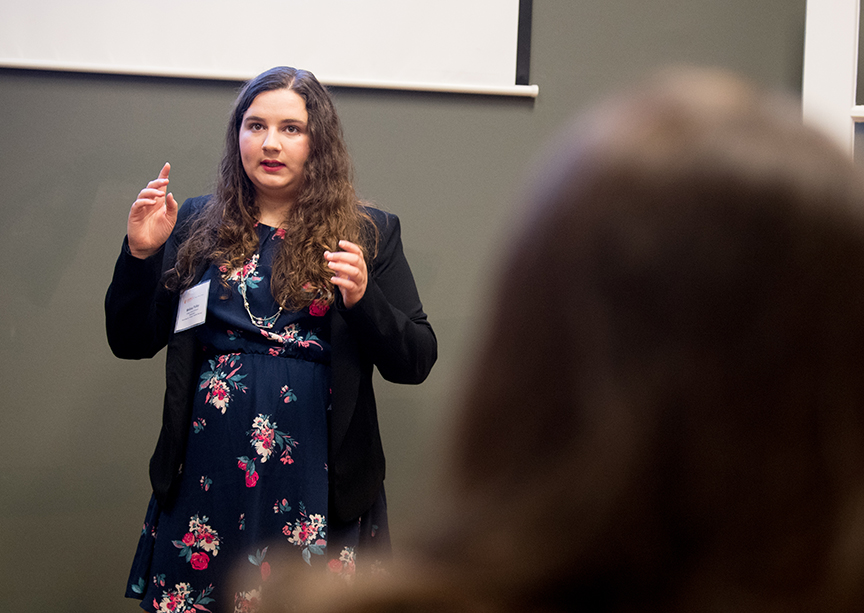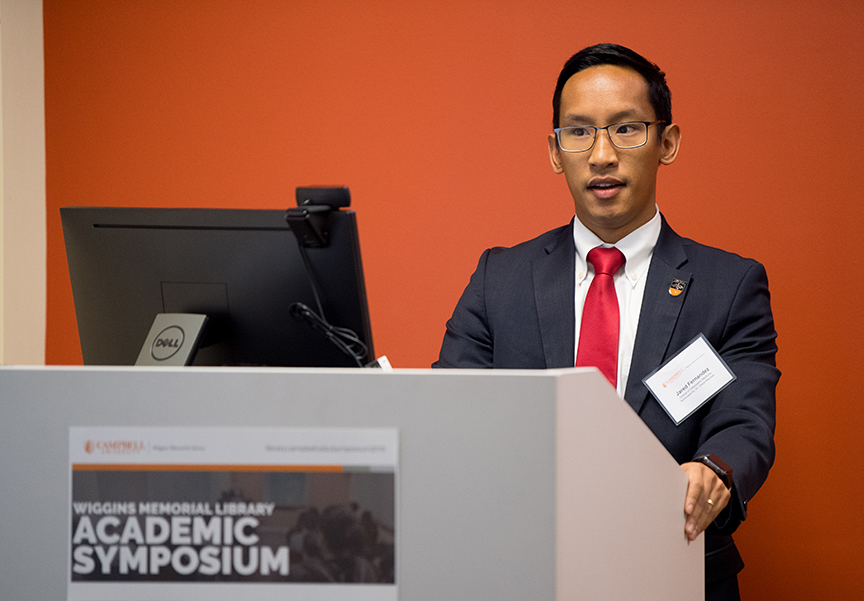According to senior math major Melissa Pulley, “math anxiety” is a very real thing, and it’s what is keeping many students — particularly women — from pursuing it as a career.
Pulley presented her research on the subject at Tuesday’s annual Wiggins Memorial Library Academic Symposium, which featured more than 140 oral and poster presentations this year. She even linked math anxiety with the Symposium itself, admitting some of her peers — while browsing presentations to simply attend for class credit — balked at the idea of sitting in on a 20-minute math discussion.
Pulley walked her 9:30 a.m. audience through statistical models that demonstrated how math anxiety, or self-reported discomfort when attempting math, has been proven to discourage the pursuit of STEM careers. A Likert scale survey helped Pulley and her team draw conclusions on the subject.
“My research partners and I have a common interest in math education and how, unfortunately, math is often taught in a way that discourages students from pursuing it,” she said. “We concluded that math anxiety can be reduced if teachers portray more positive attitudes toward math, and colleges recruit non-anxious math teachers.”

Pulley, who will seek a Ph.D. in applied math after graduation to study the use of modeling and other tools to analyze U.S. education policies, built a dynamical system to show when anxiety around this subject tends to begin. She said the anxiety affects women more, and her researched showed that female teachers who are uncomfortable performing math can have a negative impact on students — those elementary and middle school years are when those students are most susceptible to developing a math bias.
“Part of encouraging more students to pursue STEM careers means encouraging primary and middle school teachers to confidently approach mathematics,” said Pulley as she concluded her 20-minute presentation. “Career development initiatives could help reduce math anxiety in employed teachers.”
Those whose math anxiety was strong enough to keep them from Pulley’s presentation had plenty of other subjects to choose from on Tuesday. English, Divinity, physical therapy, osteopathic medicine, history and exercise science were all represented, and that was just in the first hour.
Hands-on research
Second-year School of Osteopathic Medicine student Jared Fernandez’s presentation “Manipulative Treatment in Non-Primary Care,” studied the benefits of Osteopathic Manipulative Treatment (OMT) — the therapeutic application of manual pressure or force to treat patients — on symptoms, injuries or diseases other than lower back pain (the most common ailment where OMT is applied). Fernandez looked at 704 published articles on the subject and narrowed his own study to 177 of those that met his criteria for the presentation and involved primary care physicians.

In those studies, OMT was used to as an alternative to (or in addition to) narcotics for pancreatitis, carpal tunnel syndrome, pneumonia, irritable bowel syndrome, Parkinson’s disease and even for treating pre-term infants. Fernandez found that in most cases, OMT improved health outcomes and reduced medical costs and length of stays in hospitals for a multitude of diseases and for multiple age groups.
“For years, physicians were educated that if they prescribed these powerful painkillers, their patients would love them,” Fernandez said. “Now, with the opioid epidemic opening a Pandora’s Box, manipulative medicine provides not a way to completely close it, but a way to help manage it and help people get off opioids.”
Mother issues, roommate issues
Junior English major Lydia Huth took to the podium Tuesday and asked her audience a question that had them stumped: Have you ever wondered why kids in young adult novels always seem to be to mysteriously missing one or both parents?
As Huth discovered, the missing parent trend is not confined to young adult literature. She challenged the room to name a mother figure in any of Shakespeare’s myriad of works. Only two surfaced, and these were the topic of Huth’s research presentation “Volumnia and Gertrude as Renaissance ‘New Mothers.’”
Her presentation led to a discussion of women’s roles in the Early Modern era and the fine line women trod to balance their inherently low social status and their great responsibility in to produce heirs in a patriarchal society.
Senior communications studies major Carson Murphy has seen a lot of conflict between roommates arise over the past two years as an RA. Her own experience as a freshman living with a total stranger for the first time led her to ask how understanding intercultural communication could improve resident life interactions.
Murphy’s research, “Resident Halls and Race Relations,” determined that the majority of roommate conflicts were issues over disrespect of space and property or disagreements over what constitutes cleanliness.
“What these issues boil down to is a difference in cultural beliefs about living space,” explained Murphy. “Because 70 percent of freshmen do not know their roommates before moving in with them, they don’t have a good understanding of the culture they are coming from.”
Murphy’s research led her to a statistically significant study on how cultural backgrounds tend to influence communication styles between students. For example, an Asian-American student from a rural community was more likely to avoid direct conflict with a roommate than an African-American student from an urban community. Murphy’s audience pointed out that socioeconomic differences between roommates influenced their communication styles as well.
The winners
More than 150 students showcased their research and artwork with visual displays and oral presentations at this year’s symposium, while 5 students took part in a virtual symposium by hosting video presentations online.
UNDERGRADUATE ORAL PRESENTATIONS
- 1st: Mary Gatti, “The Effectiveness of No Child Left Behind on National Test Scores,” Dr. David Thornton, Political Science
- 2nd: Nathan Ameen, “Sickle Cell Trait in Division I Football Player,” Dr. Sarah Christie, Exercise Science
- 3rd: Brendon Noyes, Joshua Wade, and Hanna Whitehurst, “North Carolina Vaccination Policy Reform,” Dr. John Mero, Political Science
GRADUATE AND PROFESSIONAL ORAL PRESENTATIONS
- 1st: Brian Conner, Jared Fernandez, Josh Shurley, Thomas Turner, and Chris Walker, “Investigation of Microbial Involvement in the Pathogenesis of Atherosclerosis,” Dr. Bonnie Brenseke and Dr. Terence Mitchell, Osteopathic Medicine
- 2nd (tie):Kyle Admire, Julia Brogdon, and Brian Gorman, “Use of Anti-tNASP Antibody for Cancer Detection,” Dr. Oleg Alekseev, Osteopathic Medicine
- 2nd (tie): John Manor, “Fitness and Fatness: Body Mass Index versus Body Composition,” Dr. Jennifer Bunn, Physical Therapy
- 2nd (tie): Laura Barbalato and Nicholas Luibil, “Investigating the Potential Cardiotoxicity of Synthetic Cannabinoid JWH-073,” Dr. Bonnie Brenseke, Osteopathic Medicine
UNDERGRADUATE POSTER PRESENTATIONS
- 1st (tie):Gabriela Amadeo and Timothy Mangum Jr., “An Examination of Brain Waves Associated with Lying,” Dr. Jutta Street , Psychology
- 1st (tie): Samantha De Arcia, Joshua Kirkman, Megan Robillard, and Lowell Taylor, “Utilizing the Design Thinking Process,” Dr. Kevin O’Mara, Business
- 3rd: Olivia Sisson, “Development of an in-game cardiovascular load score for female lacrosse players,” Dr. Jennifer Bunn, Physical Therapy
GRADUATE AND PROFESSIONAL POSTER PRESENTATIONS
- 1st: Melissa Pullen, “The Association between Military Service and Environmental Toxicant Exposure from 1999 to 2014,” Dr. Charles Carter, Clinical Research
- 2nd: Rebecca Hilleary, Sarah Jabusch, and Becky Zheng, “Assessment of Real-World Data for Evidence for Gender Disparities in the Provision of Education amongst Patients Diagnosed with Coronary Heart Disease,” Dr. Charles Carter, Clinical Research
- 3rd: Eric Hexem, David Ho, Taylor Ibrahim, and Ani Mnatsakanian, “Intramuscular Lipoma: An Uncommon Presentation of a Common Pathology,” Dr. Bonnie Brenseke, Osteopathic Medicine
FINE ARTS
- 1st: Rachel Dickerson, “Fo,” Prof. Larkin Tysor
- 2nd: Matthew Thompson, “Skull Study,” Prof. Breck Smith
- 3rd: Amber Merklinger, “The Hum of Bees,” Prof. Brian Bowman
VIRTUAL SYMPOSIUM VIDEO PRESENTATIONS
- 1st: Katherine Huynh, “The Relationship of Age and Conformity in a Group Yoga Class,” Dr. Katherine Van Allen, Psychology
- 2nd: Justin Anderson, “Displays of Various Levels of Aggression: Adolescents Versus Adults,” Dr. Katherine Van Allen, Psychology
- 3rd: Sheronda Rone, “Learning Strategies for Elementary Students,” Dr. Terrie Bethea-Hampton, Professional Education


